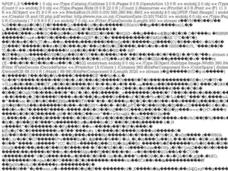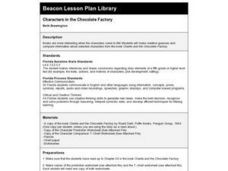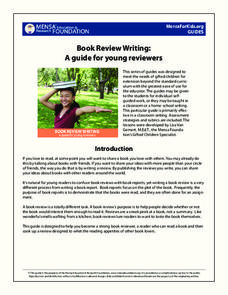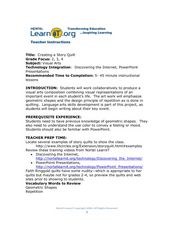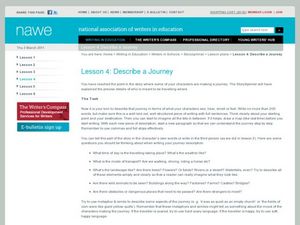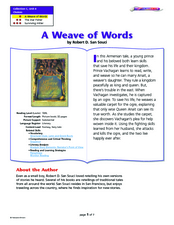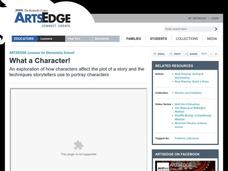Curated OER
Literary Element: Point of View
In this literacy worksheet, learners focus upon the element of literature know as the point of view. They use the story and discuss the first and third person context.
Read Works
Protagonist
Teach your class how to identify the protagonist in a story. The plan suggests starting with a protagonist from a tale you have previously read in class. Then, you can read a new story and work together to identify the protagonist,...
Curated OER
Incorporating Reading Comprehension Using Cinderella Stories from Different Lands
First graders investigate Cinderella tales from different lands to discover their commonalities in this unit. They perform their favorite Cinderella story.
Curated OER
Understanding Fantasy Fiction
Students investigate storytelling elements by writing their own fiction stories. In this creative writing lesson, students listen as the teacher reads a fictional story. Students analyze the lack of rules in the story and...
Curated OER
Prometheus Eulogy
Students write a eulogy for the mythological character, Prometheus. In this Greek myth lesson, students read a story about Prometheus and view a PowerPoint. Students discuss the elements of a eulogy and then write one for Prometheus.
Curated OER
Characters in the Chocolate Factory
Students dress and act as selected characters from Roald Dahl's "Charlie and the Chocolate Factory". They identify each other and make predictions about the upcoming chapters based on their observations about the characters.
Curated OER
Fabulous Fairy Tales
Students examine how story telling using literary elements found in fairy tale genre is one way to read and retell, discuss and analyze, as well as write and produce their own fairy tales.
Prestwick House
Star Wars and the Hero's Journey
Is Luke Skywalker the archetype of a literary hero? Follow the path of the Hero's Journey with an engaging lesson that details the plot structure, applies it to Star Wars: A New Hope, and invites class members to choose their own...
MENSA Education & Research Foundation
Book Review Writing: a Guide for Young Reviewers
Encourage scholars to share their love of reading with informative and engaging book reviews. Here, you'll find a series of guides that walk learners through the review writing process. Included in the collection is information about...
Curated OER
Marvelous Mysteries
Fifth graders explore mystery stories. In this reading and writing lesson, 5th graders complete a planning guide for an original mystery. Students use the writing process to create a mystery story.
Curated OER
The Wind Blew
Students look at a picture book and observe what the facial expressions show. In this character's feelings lesson, students write what they think the character might be saying on each page and the punctuation they use. ...
Curated OER
Revising Your Mystery Story
Learners edit and improve their short stories by examining character description, dialogue, and plot elements. In peer editing groups they correct gramatical and spelling errors. they read aloud their new story drafts.
Curated OER
Using Inspiration Software to Explore Characters In Stories
Young scholars identify characters, their qualities, and examples of their qualities and use Inspiration to organize them in a clear and understandable format. After a lecture/demo, students use the program on the next story by themselves.
Curated OER
Speak What We Feel, Not What We Ought to Say
High schoolers examine and create their own interpretation of a particular character from the play, King Lear. They read the speeches, write a paragraph about their character, and present a short performance of their scene.
Curated OER
"I am Not Well": Unspoken Endings and Unscripted Scenes
High schoolers analyze Act 4, scene 1 from the play, Merchant of Venice. They hypothesize the content of an unscripted moment and response, look for evidence in the text to support their hypothesis, rewrite the scene, and perform it for...
Curated OER
Creating a Story Quilt
Students create a quilt to represent an important event in their life. In this visual arts lesson plan, students research Faith Finggold and her quilts. Students use art supplies to create their own quilt and share the symbolic meaning...
Curated OER
Elements of Fiction
Students investigate themes and settings in their favorite fiction stories. In this creative writing lesson, students discuss the reasons a fictional story works well and discuss ways to create their own. Students create...
Curated OER
The Holocaust: Retelling the Story
Students compare and contrast two different presentations of Holocaust experiences. They participate in class discussions and write journal entries to explore the differences between the book "Until We Meet Again" and the film "Devil's...
Curated OER
Thrilling Information: Music and Reading
Here’s a cross-curricular program music activity that uses Peer Gynt to engage class members. Groups take one section of “In the Hall of the Mountain King,” choreograph their section of the tune to represent the story as they imagine it,...
Curated OER
Greed is Good?
From Mr. Merdle to Mr. Madoff? A viewing of the PBS adaptation of Charles Dickens’ “Little Dorrit” launches an examination of greedy characters in literature and a study of greed, unfairness, and economic hardship today. The richly...
Curated OER
Describe a Journey
Students describe the sensory experience of a character's journey in an essay. In this precise details writing lesson, students explain the effects on the senses of weather, time of day, landscape, and other...
Curated OER
A Weave of Woods
Focus on vocabulary, comprehension, and analysis while reading A Weave of Woods, a colorful picture book by Robert D. San Souci. Young learners use worksheets to preview, predict, practice paraphrasing, and make comparisons. The...
Curated OER
Plot Development
Students identify the elements of plot and write a script with a strong plot. For this plot lesson, students identify elements of plot in examples by completing a chart and a graphic organizer. Students then create plots from...
Curated OER
What a Character!
Students look at the role of characters in a story. In this character lesson, students discuss how different types of characters change the plot of the story. They see how storytellers use their body, face, and voice to tell stories.



